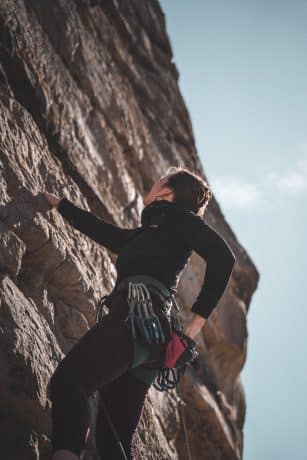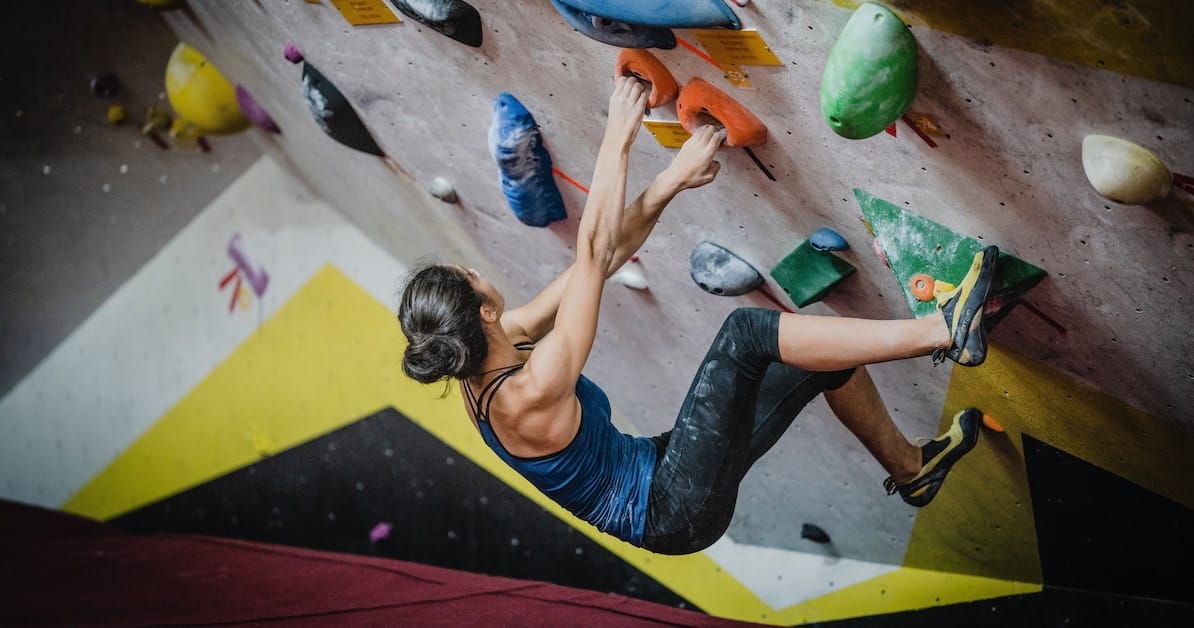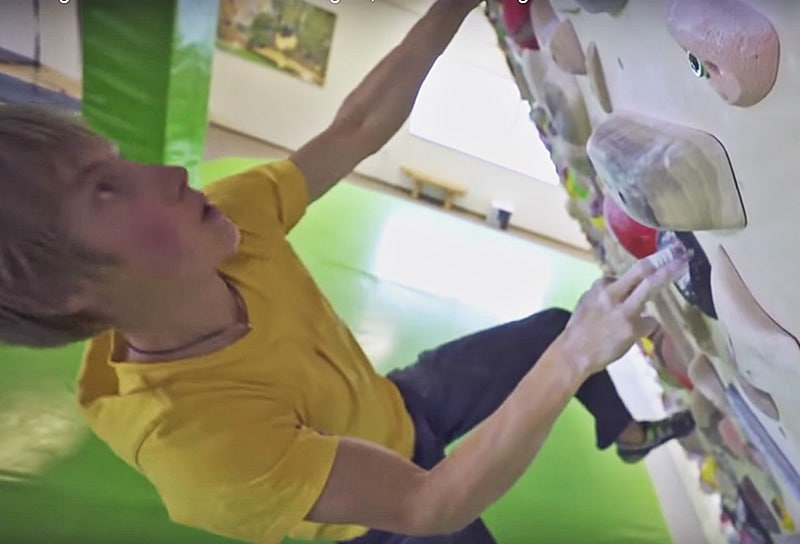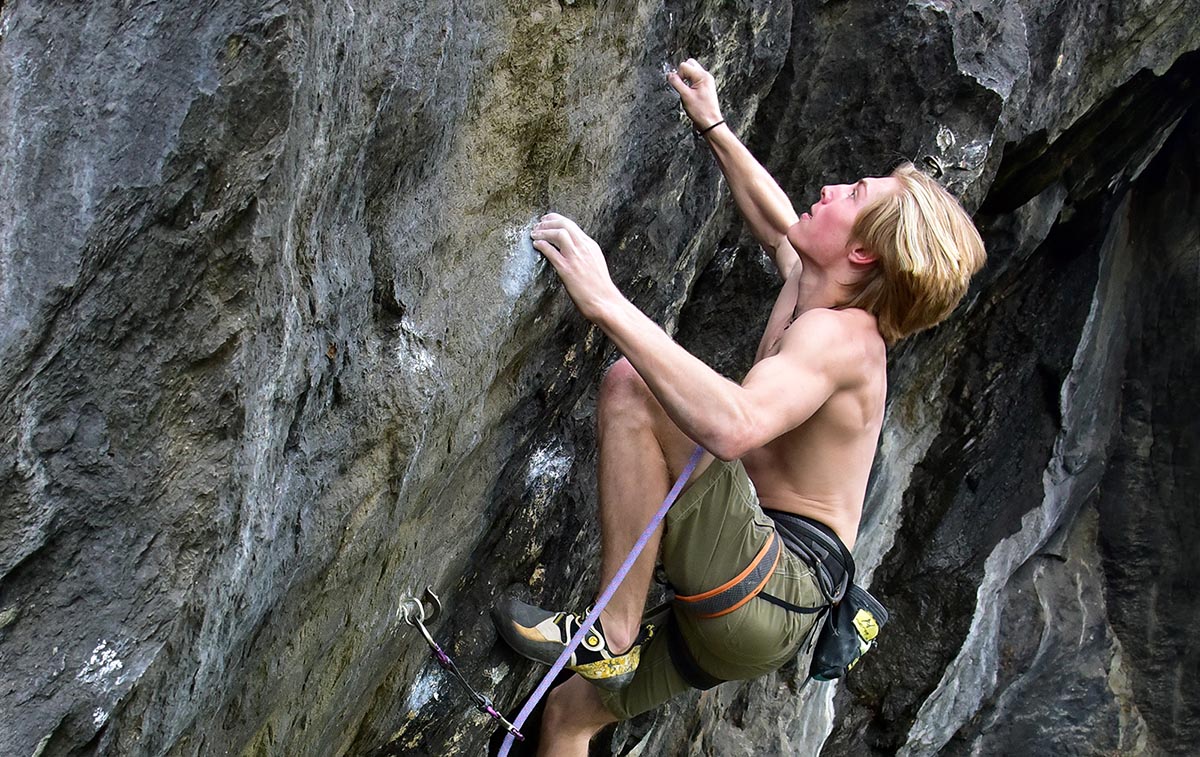Training for training’s sake alone won’t get you very far. But training with a purpose and a plan leads to monumental growth in minimal time. Learn to train with intention without overcomplicating your routine, and climb effectively by making the most of your time on the wall.
(This article was originally published in January of 2020, but these five core elements of climbing stand the test of time.)
5 Training Tips for Climbing More Effectively

Outside or in, climbing regularly is the biggest key to improvement.
Climbing effectively means using your skills and strengths wisely. It’s easy to just
“get strong”, and much harder to put that strength into real practice. Make sure your training time goes somewhere valuable with these tips for both simplifying and refining.
1. Climb Regularly and Consistently
Many climbers forget that climbing is first and foremost a skill sport. Increasing your climbing economy through a focus on footwork, movement, and acquisition of new skills is the fastest path to the higher grades. Unless you already climb at the 5.13 level or higher, time spent climbing is the most important element of your training program. Find a way to schedule at least two climbing sessions per week, while three to four is ideal. Any bouldering or roped climbing session, either indoors or out, counts towards this total. Keep a consistent schedule in order to cement this time into your routine. All of those sessions add up over time to create a strong foundation for your climbing future to build off of.
2. Get Stronger
Once you’re in the swing of a consistent training schedule, then you can focus on strength. Start by committing to two focused strength training sessions per week. Schedule these on hard bouldering days in the gym, or—if only climbing two days per week—on separate days to reach a total of four weekly training days.
Detailing the exact nature of these strength routines is beyond the scope of this article, and there’s really no one-size-fits-all workout that I could prescribe anyway. But begin with a focus on increasing maximum strength in the finger flexor and pulling muscles via high-intensity, high-load exercises that produce failure within five to fifteen seconds. Any exercise lasting longer than that ends up training endurance rather than maximum strength. After a good warm-up, select exercises such as weighted pull-ups, minimum-edge or weighted fingerboard hangs, one-arm pull-ups, campus training, etc.
Take a three-minute rest between each set and exercise. For example, assuming a 10- to 15-minute warm-up, you can select up to fifteen total strength and power exercise sets in the 45 or so minutes remaining. Conclude your workout various core-training exercises as well.
3. Climb with Purpose
Sub-elite climbers should consider employing a periodized training program that alternates back and forth every few weeks between a training focus on max strength/power versus power-endurance and local aerobic endurance. This balance might fluctuate throughout the year depending on your climbing goals. During off-season training, for example, you’d do well to spend more time training strength/power than endurance. A sample schedule during this time of year might look like alternating three to four weeks of strength/power training with one to two weeks of muscular endurance training.
As performance sport climbing season nears, transition to an equal (or greater) number of endurance workouts. One way to do this is to alternate two weeks of strength/power training with two weeks of endurance training. In the midst of performance sport climbing season, you might even opt for one session of each every week. This is called Daily Undulating Periodization. An example of this schedule for your typical weekend warrior might look like training strength/power on Tuesday, power-endurance training Wednesday, antagonist and (easy) local and generalized aerobic training Monday and Thursday, total rest on Friday, then climbing outdoors on the weekend.
No matter how you schedule these endurance sessions, “climbing intervals”are your best bet. These alternate pumpy climbing with rest periods. One popular method involves climbing at near-maximal intensity for ~30 seconds, followed by rest for ~30 seconds, and repeated for a total of four intervals.
After resting for four or five minutes, perform another set of four intervals. Rest and repeat for up to four total sets and you’ll have completed a great power-endurance workout! Another approach that targets local aerobic endurance rather than power-endurance takes a series of submaximal (i.e. only a light to moderate pump) roped climbs lasting three to six minutes each. Rest for three to six minutes between these roped ascents, while your belay partner completes their climbs, and repeat for four to eight sets.

Climb effectively by giving each training session and cycle a purpose.
4. Rest and Recover
Eating right, getting enough sleep, and resting from climbing makes a real difference in the long run. Training breaks you down, and rest is where your body has the chance to build back stronger. Complete recovery is the key to climbing at your absolute limit. If you train hard and frequently, you may not even know what it feels like to be 100% recovered! Realizing the full benefits of your training, however, demands smart nutrition and effective rest habits.
Each of these factors must be tailored to the individual. Seek advice from PhysiVantage athlete and sports dietitian Amity Warme, or consult your primary care physician. But in general, aim for six to eight hours of sleep and three to six quality feedings per day. By “quality feeding”, I mean a healthy meal or snack that contains the trifecta of macronutrients: protein, carbohydrate, and healthy fats. Supplemental whey protein is a bonus for muscle strength and recovery. Supercharged Collagen also aids in supporting tendon, pulley, and muscle matrix health and strength. Top it all off with a steady stream of hydration throughout the day.
5. Diversify Your Training
Climbing demands more than just strong fingers. Supplement your climbing-specific strength training with some supplemental strength training of the opposing muscles. This habit maintains muscle balance, prevents injury, and increases your overall fitness and well-being beyond just climbing. Start with four to eight sets of pushing exercises using a weight that allows for 12 to 20 repetitions. Exercises like the shoulder press, bench press, incline bench press, pec flys, and dips all target the large muscle groups in your upper body. Climbers often overlook “leg day” as well, but the posterior chain muscles (legs, hips, lower back), are crucial for developing power and maximizing reach on the wall. A few of my favorite exercises include deadlifts, squats, glute bridges, hip thrusts, and planks. Be sure to enlist the help of a dedicated strength and conditioning coach if you aren’t sure how to properly execute any of these lifts.
Beyond the realm of strength, be sure to move your body in various ways. It’s that simple. Lift some weights, go for a run, ride your bike, do some laps in the pool, or even go for a daily walk. Climbing is fantastic exercise for both the body and mind; but we’re made for more than just scaling walls. A wide variety of movement patterns will benefit your overall health. On top of that, you’ll likely learn important lessons about how your own body functions best that you can bring back to your climbing.
RELATED LINKS:
- Fueling for Sending with Amity Warme, Climbing Dietitian
- Pursue Climbing Mastery by Diversifying Your Climbing Skill Set
- Maximum Strength Training for Climbers
- Aerobic vs Anaerobic Training for Climbing
- Recharge Your Climbing Batteries for Energy and Improvement
Copyright © 2000 – 2023 Eric J. Hörst











